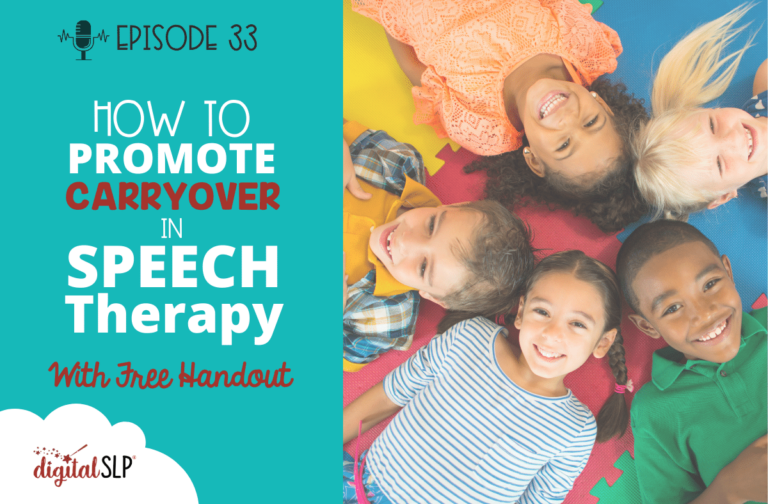Parent involvement in therapy is important to maximize treatment results. In this episode, I talk about how to better incorporate parents within therapy sessions and home practice in order to obtain the very best results for our clients overall. Tune in below to learn more and be sure to check out the links and resources section at the bottom of the page!
How to gain parents’ involvement within the therapy process? Although challenging, parental involvement in therapy is an important key part of the process.
Some tips and strategy for parent involvement in therapy:
- Begin the therapy process by explaining to the parents the importance of their involvement in helping their child to meet their goals. Lay out clear expectations and educate them about the role of parents their role within the therapy.
- Create goals together. Ask the students and parents the goals they want to work on to create a family-centered approach.
- To begin the session with open-ended questions with parents – provide them the opportunity to talk.
- Teach parents strategies they can use at home to continue working on the child’s goals. Coach them how to perform the strategies and have them try them out there in your session (if possible). Also, you can provide package of information they can take home.
- Make it functional while involving the whole family. For instance, home practice involving the whole family with the student’s younger or older siblings.
- To create effective home programs to support the students to better achieve their goals.
Links & Resources
- The Digital SLP Membership
- Lauren Lowry – Hanen SLP & Clinical Writer
- Create-A-Story Homework Helper
- Articulation /G/ Sound Homework Helper
- Core Word Work Parent Handout: PLAY
- Articulation Homework Helper: K SOUND
- Word Of The Week Homework Helper: MORALE
I have recently written a blog about how we as SLPs can take to best support parents in parent coaching. If you are interested, do check it out here.
Full Transcript of Podcast: Parent Involvement in Therapy to Maximize Treatment Results
Episode 75: Parent Involvement in Therapy to Maximize Treatment Results
You're listening to the Speech Space Podcast, a podcast full of tips and resources for SLPs. I'm your host, Jessica Cassity, and this is Episode 75.
Hello there everybody! Today, we are going to be talking about how to incorporate parents within therapy sessions and home practice in order to obtain the best results for our clients. So before we get started, I did want to mention that this podcast is brought to you by The Digital SLP membership site, which is a site that features time-saving, interactive digital resources that are all teletherapy platform-friendly. If you want to learn more about that, you can head on over to thedigitalslp.com/digitalslp. And I also did want to let you know that we now are offering a free 7-day trial. So if you want to get a free trial, you can go ahead and do that at that link as well.
All right. So let's go ahead and jump on in and talk about how to gain parent involvement within the therapy process. So getting parents invested in their child's therapy can definitely be challenging sometimes, but it's a very important and key part to the therapy process. So according to research, working closely with our family supports a family system that is associated with positive reactions from parents, in turn relating to positive gains in their child's development, and that is from Trivette, Dunst, and Hamby in 2010. Providing parents with the tools needed to support their child will help them to feel more confident, more capable, not only to participate within therapy sessions but also to continue to work on goals with their child through home practice as well. You know, there are many barriers that I know several of you therapists listening face. And when you're trying to get parents involved in sessions, I know it can be a little bit of an uphill battle sometimes. Some of you may be within the school system, and only ever see parents at annual IEP meetings, or some of you might be providing teletherapy, but the child's nanny or grandparent is the one joining your client for the session every week. Or maybe the parents are physically present during your sessions but not actually participating in the sessions. So there are so many different scenarios where parents are not able to be present for therapy sessions. So how do we help parents to become more involved within therapy sessions and feel more a part of the therapy process? So let's talk a little bit about what that looks like. So we're going to go over some tips and strategies that you can implement to try to involve parents within therapy.
So number one is begin the therapy process explaining the importance of parent involvement. So you want to set that tone in advance. So according to The Hanen Centre, several parents expected that the SLP would be the one carrying out the therapy directly with their child. Parents were willing to be involved within the therapy process but they were uncertain about what would be expected of them. And some of them felt a bit anxious about their involvement. So parents reported feeling uncertainty about their ability to carry out intervention at home. So, you know, that tells us that we need to be mindful of that, and we need to be educating our parents about the role of parent involvement. So before you even begin treating your patient or client or student, you want to start off by explaining to parents the importance of their involvement in order to see best results. Many parents believe that they just dropped their child off, the SLP provides the therapy, they picked their child back up, and then they go home and that's it. You want to let them know that parent involvement is key. And if you're already seeing a patient and trying to get parents more involved, start having a conversation with parents during your next therapy session, explain to them the importance of their involvement in order to help their child meet their goals. You could even provide some research if you feel like that would be beneficial. By laying out clear expectations, parents will not feel as anxious since they have a better idea of what is expected, and understand how they can better help their child.
The next tip is to create goals together. So you've evaluated a new client, and now you're looking at creating a plan of care, full of great goals to target in therapy. You want to discuss these goals with the family. You want to ask the parents what their goals are or ask the student, if they're old enough, what goals they would want to work on. You want to make the goal-writing process a family-centered approach. Now this will help you to create more functional goals that apply to the client, both within therapy sessions as well as at home. By developing goals without parent input, you may be developing goals that are not functional in the child's home. So you definitely want to be working collaboratively with families to ensure that you're creating meaningful and tangible goals. If you're working in the schools and you're not able to discuss goals with the parents in person, you can send your report home with your goals so the parents can review them, and then they can send back any feedback. And of course you want to let the parents know that they can reach out to you any time. And ideally you could try to reach out to them to discuss those goals, if possible, before you finalize your report.
The next tip is to begin therapy sessions with open-ended questions for parents. So instead of just diving right into your session, take a few minutes in the beginning to ask your parents about the previous week. Ask open-ended questions to allow for more communication. Instead of asking something like, did your child do his or her homework this week? Or did you have any questions about the homework for last week? Try something like, tell me something new that happened this week. And of course, we're hoping that we're going to be getting a response about their speech and language goals so you can get a little more specific if you need to. Tell me something new that happened this week surrounding your child's goals or something that you noticed about your child's speech. Provide parents the opportunity to talk. Don't be afraid to allow the client to play independently at this time while you chat with the parent. It's important to be talking with parents and setting aside time to discuss what's working, and what's not working at home to target goals appropriately. Even if you are not providing direct therapy, the entire therapy session, coaching and talking with parents is part of the therapy process. So that's something to keep in mind.
My next tip is to teach parents strategies. So you want to teach parents strategies that they can use at home to continue working on their child's goals. You want to coach parents on how to perform the strategy that you're showing them, and then have the parents try this strategy out with you there in your sessions, so you can provide them instant feedback. You want to also ensure parents that you're there to support them. And you want to help them to feel comfortable and understand what it is they need to do at home before they leave your session. If parents aren't able to be present, you can provide them with strategies explained either by email or by phone call. You can provide the child with information, a packet of information that they take home. I know sometimes that can be a barrier because you're not sure if that's been received on the other end. But you just want to try your best to explain what you've been working on, and talk about how they can continue to work on this skill at home.
My next tip is to make it functional while involving the whole family. As soon as the child goes home, they may not be able to sit down one-on-one with their parent in a quiet space, and complete their home practice. You want to explain to parents that a home practice can still involve the whole family, so it doesn't need to be like it might be say, you're working in a private practice where you're seeing a student in a quiet room one-on-one. You can get the whole family involved, encourage younger and older siblings to join in when working on the goals at home. For example, if your student is working on, say prepositions, explain to parents to have the student take turn with their siblings, hiding items around the house, and then giving each other directions on how to find the items. So instead of just telling parents to go home and work on prepositions, you want to provide them with game ideas and explain how to make that game into a whole family experience. You know, we, as therapists have more experience making our students' goals more creative and thinking outside of the box. So provide parents with those tools and ideas to make it easier for them as well, because the easier you make it for them, the more likely it's actually going to happen.
And my last tip is to create home programs. Creating effective home programs will help to support your students to better meet their goals. You only work with your students likely say once or twice a week, and it's generally for a pretty short amount of time. It's not enough time if the student is only working on their goals one hour or maybe even less per week. So by working together with families to come up with goals and activities that they can then work on at home, the student is more likely to meet the goals and see more progress. So we want to talk with parents about their home setup in order to determine how the student will partake in a home program. You want to talk with the parents about the time that they will be able to set aside to work on their child's goals. By planning this out with parents beforehand, they are able to better visualize what this might look like and have more of a schedule to stick to rather than just randomly finding time. You know parents' lives are busy. You want to make sure that you understand this, and help them to find a time within their busy schedule, even if it's for a short amount of time to work with their child. This will also help your students since it will develop more of a routine and it will be scheduled into their week. You also want to create specific plans with your families during school changes, vacations or times off. Talk with parents to make sure that there's a plan in place to continue to work on goals during this time. You know, summer's a big one, a lot of families take lots of vacations. And during that time they can still, say when they're driving, maybe that's a long drive to get to their destination. They can sneak in a little of that speech and language homework in the car.
Lastly, provide fun ideas for parents to try at home. Begin compiling written descriptions of easy and fun activities. Like some of the ones that we talked about today that you can just hand parents to try at home. You can also find resources online for parents to do with their child at home. You can send them links to make it easier. If they are, if you're communicating in an email, I've also included a few Digital SLP resources that you can provide parents to use at home. If you're a member and you have access to the QuickLink feature, which you do, as long as you have a subscription above the monthly level, then you can provide those links to parents and they can use those within their home program as well.
So I hope that you found all that helpful. Having said all of that great stuff about home programs, I do just want to reiterate that parents are so busy, and you know, sometimes families can be going through different paces of life. So we really do want to have patients with our families. You know, in a perfect world, we would have these programs work seamlessly, and we would have homework and one-on-one time or family time, you know, surrounding goals completed each and every week. But we know that's just not realistic. So give your families some grace as well if they're not always able to stick to these things. Like I said, you know, there can be different seasons of life where, you know, families are going through different issues or maybe they're just very busy. They have a lot of young children at home, and we just want to be patient, and we want to try to empower them. So these are some strategies that you can try to implement. And I think you'll have great success doing that a lot of the time, but just know that there are times where, you know, maybe, maybe it doesn't happen and that's okay too. You know, we just want to support our families in the best ways that we can. So again, I hope that you found this to be helpful. If you want to learn more about The Digital SLP membership, you can do that by going to thedigitalslp.com/digitalslp. The membership doors are open. So sign up is available at this time. And like I mentioned at the beginning of the show, the free trial is up and going as well. It's a 7-day free trial. And so you can head on over to thedigitalslp.com/digitalslp to try that out.
And lastly, if you would like to access the show notes from today's episode, then you want to head on over to bitly.com/TSSEP75. And if for some reason that link does not work sometimes, you know, it is case sensitive. You can always head over to thedigitalslp.com/podcast, or you can just search the Speech Space Podcast on iTunes, and all of the episodes with the attached show notes will pop up. Okay. I hope that you guys have a wonderful week and I will catch you again in a couple of weeks.













Recent Comments